Eating Europe’s Jordaan Food Tour: A review
Rows of pretty small houses and shopping streets lined with a mixture of hip and quirky stores, along with a smattering of “coffee shops” leaking the reek of marijuana out onto the sidewalk: this used to be my image of Amsterdam’s Jordaan neighborhood. It never occurred to me until I took a Jordaan food tour by Eating Europe that the area is also interesting in terms of its history and its food and drink.
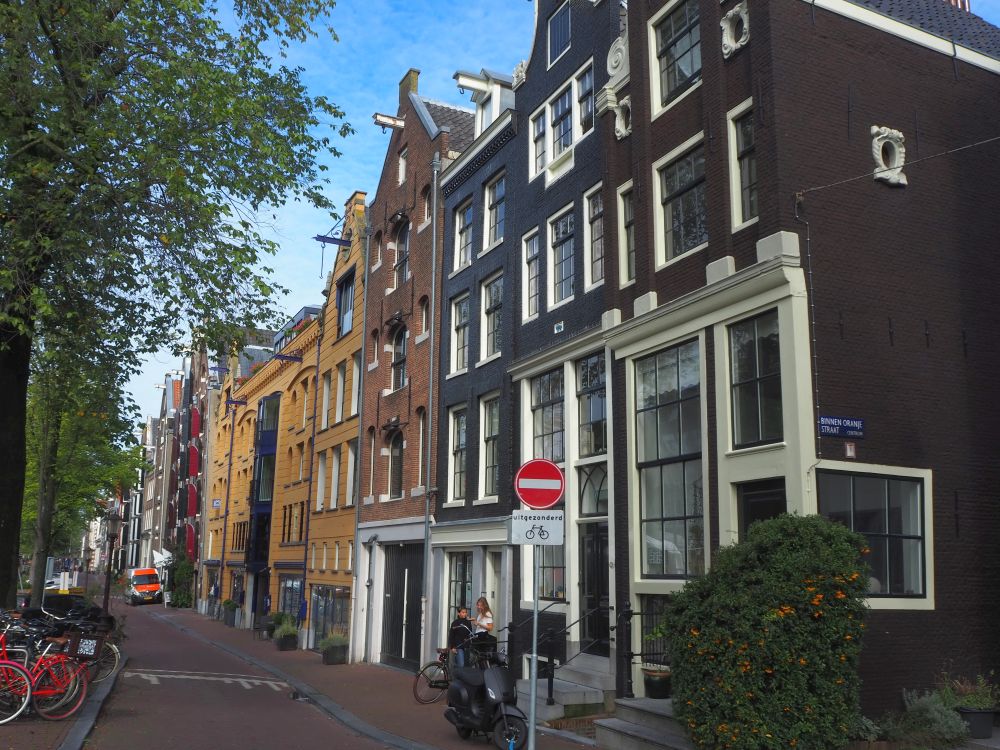
Disclosure: I was sponsored by Eating Europe Food Tours so I got the tour for free. However, rest assured that all opinions are my own.
Another disclosure: This article contains affiliate links. If you book a tour through one of the links, I will receive a small cut of what you spend. This will not affect your price.
History of the Jordaan
The Jordaan dates to the early 17th century: a neighborhood just west of the UNESCO-listed old city core, with its picturesque canals. The Jordaan is just as pretty as the city core, but the houses tend to be somewhat smaller and less ornate than the impressive patrician’s houses of the center: these were intended for the working class.
Nowadays, of course, the area is stylish and highly desirable and housing prices are, like everywhere in the older parts of Amsterdam, astronomically high.
Make sure to check out my series on small museums and other sights to see in Amsterdam!
Typical Dutch foods on our Jordaan food tour
Each of the stops on the Eating Europe tour (formerly Eating Amsterdam food tours) gave us a glimpse of a new facet of life in the Jordaan, past or present. I think I was an unusual person to take such a tour; it’s meant for tourists who don’t know anything about Dutch food. After 20+ years living here, I had already tried most of them.
That didn’t make the tour any less enjoyable, however. I’d tasted the food, but never knew much about it, or even thought about it. The tour changed that.
Café Papeneiland
In this article, I won’t go through all of the different places we stopped or foods we tasted, but I will point out a few. We started at Café Papeneiland, a pub established in the early 17th century and still going strong, judging by how full it was, both inside and at the few outside tables.
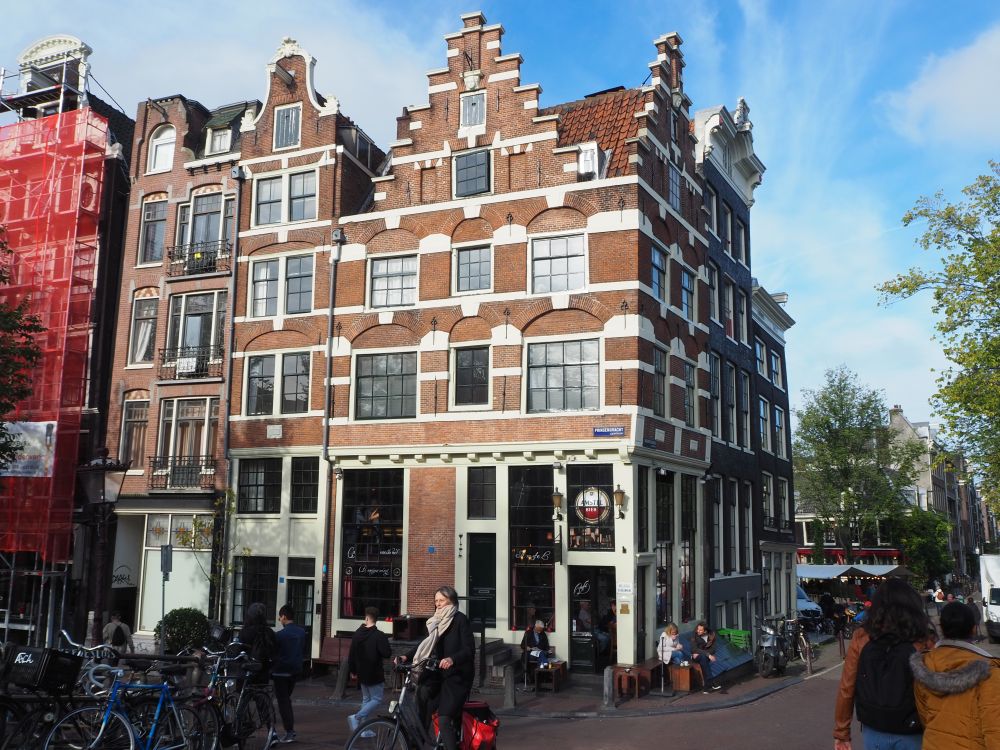
Café Papeneiland is one of two “brown cafés” we visited on the Jordaan tour; it’s a certain style of traditional pub whose dominant color is brown. Brown paneling, brown tables and chairs, often a beamed wooden ceiling: brown cafes used to have dark carpets covering the tables too, but that practice has disappeared for hygiene reasons.
All of this brown doesn’t make the café depressing; on the contrary, it creates a feeling of gezelligheid, a particularly treasured feeling of coziness, warmth and good company.
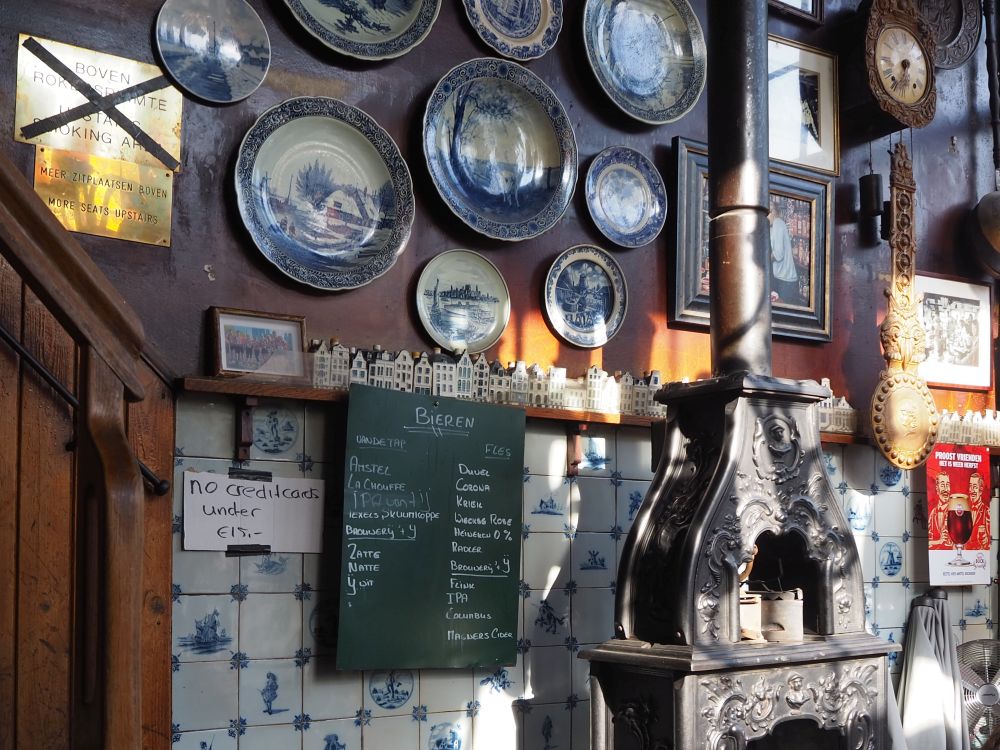
Once we had all squeezed in around a table in the corner, our tour guide, Kenny, gave us a general overview of the tour and what it involved before we got to our first food: Dutch apple pie.
Dutch apple pie isn’t like American apple pie. It’s less wet, and the crust is more cakey than American. This particular pie is served at Café Papeneiland in enormous slices. Even the half slices we ate would be normal-sized pieces anywhere else.
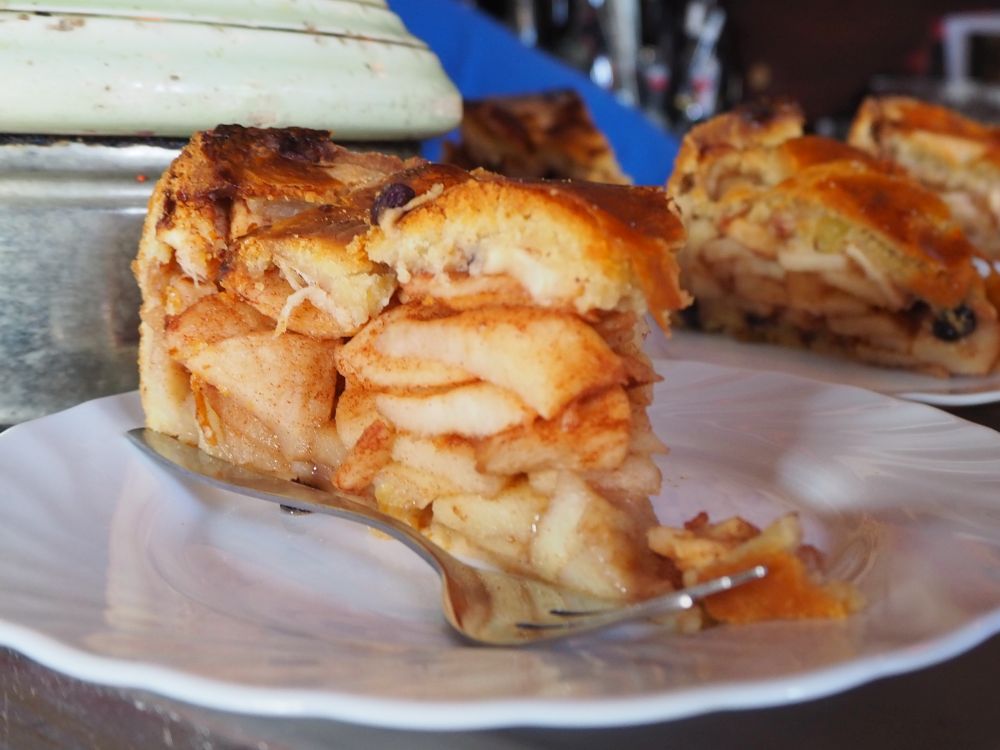
I’ve had Dutch apple pie often enough to know what good apple pie is like, and this was good: not too dry; sweet, but not overly so; the apples soft but not overcooked so they still tasted like apple.
Fish in the Jordaan
Our next stop was at a place called Vishandel, which means “fish trade.” Standing outside, Kenny gave us a quick overview of the importance of the fishing industry in Amsterdam. Fish, and particularly herring, was an important export from Amsterdam for centuries, especially once the process of salting the herring was invented in the 14th century.

Not surprisingly, we had a taste here of traditional salted herring. While normally the herring is eaten whole – you hold it up by the tail, throw your head back and lower the fish to your mouth, eating it from gill to tail – we had smaller bites to sample.
The herring is quite mild in flavor, and it’s raw: marinated for a short time in salt and vinegar. This makes it a bit on the slimy side, but not unpleasant. Our group’s assessment was divided.
We also tasted kibbeling, a popular Dutch snack made from white fish, usually cod, that is battered and fried. The group was closer to unanimous in liking kibbeling.

Colonial influences
Since the buildings we passed and the history of the neighborhood reach back to what is commonly called “the Golden Age” in the Netherlands, it was appropriate to look at Holland’s history as a colonial trading power. After all, the Golden Age wasn’t golden at all for the colonized and/or enslaved peoples.
This meant a stop at a takeaway food place called Swieti Sranang selling food from Suriname and Java. We ate chicken sate with a peanut sauce that was by far the best I’d ever tasted and Kenny gave us an overview of Holland’s history as a colonial power.
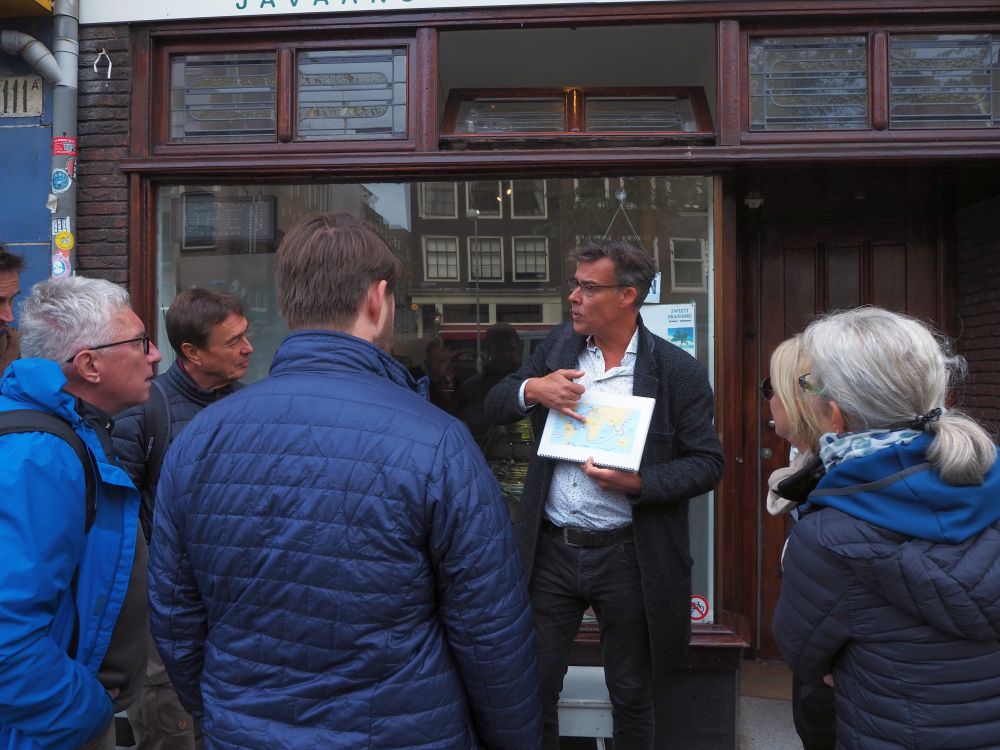
Other stops
At a cheese store which was more of a general deli, we tasted cheese of a few different types. Dutch cheeses like Edam and Gouda come in a range of ages from jong (young) to oud (old). While the young cheese is mild and creamy, the older cheese is sharper, saltier and crumblier.

At a sausage maker, we tasted three different types of meats: several varieties of sausage and a smoked ham.
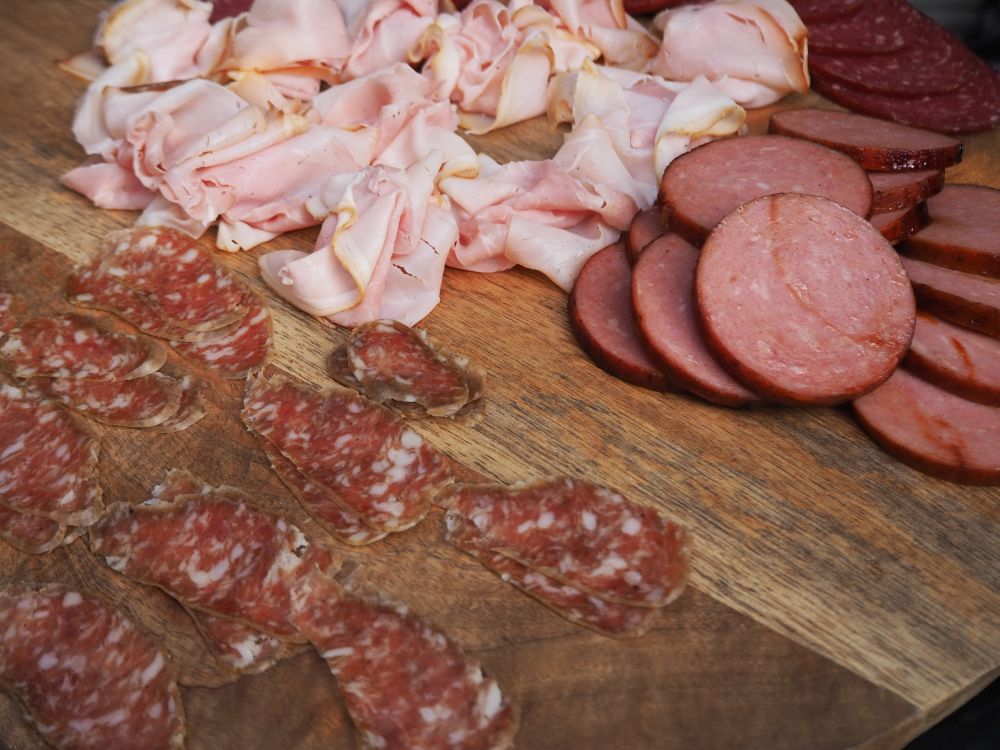
Of course, no food tour in the Netherlands would be complete without a stroopwafel: a round cookie made of two thin-pressed waffle wafers with a sweet sugar syrup between. (A tip, if you ever eat one of these: place it for a few moments right on top of a hot cup of tea or coffee. The syrup will melt and make the stroopwafel even more delicious.)
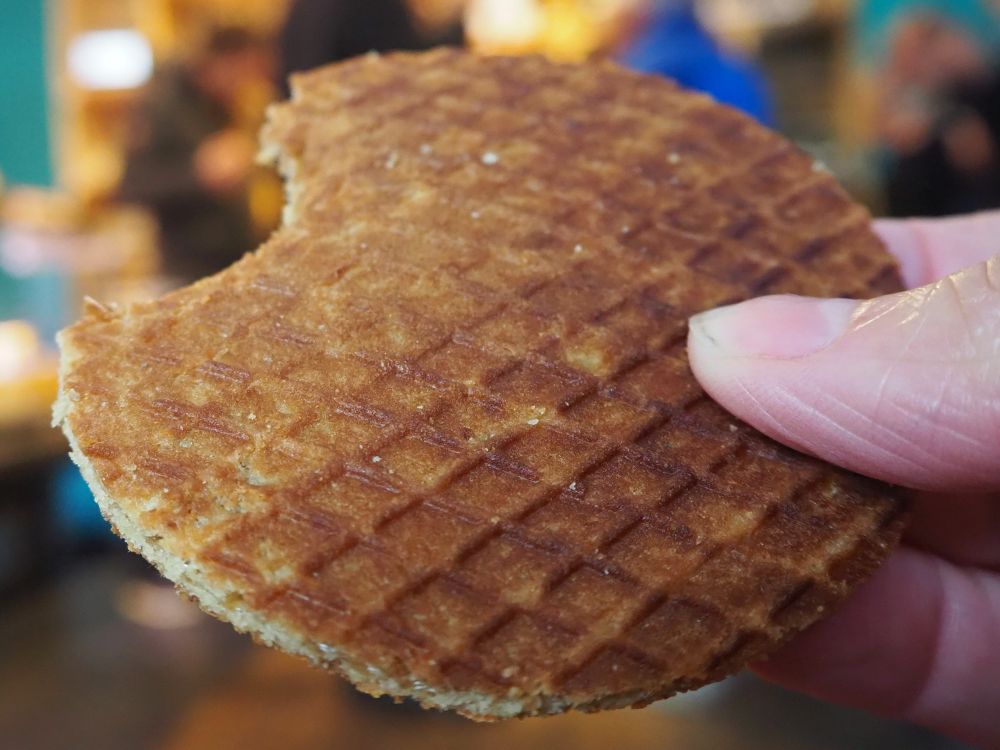
Café treats
Our last stop was at Café ‘t Smalle, another charming brown café. We filed up the steep stairway and settled in for the last tastings of our tour: poffertjes and jenever.
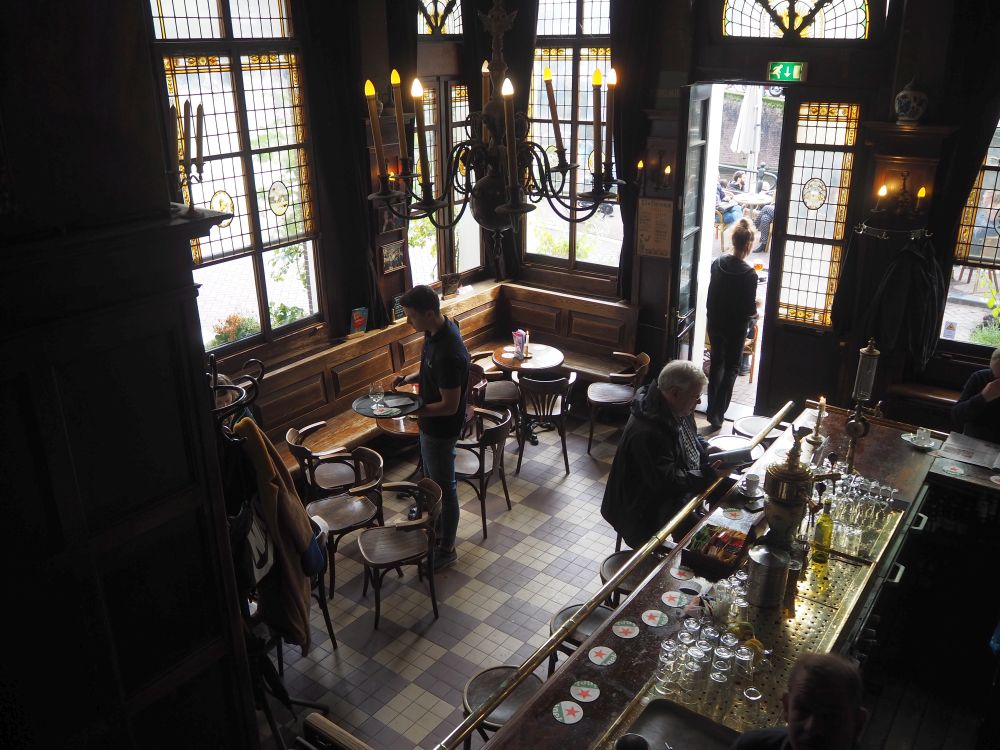
Poffertjes are very small, sweet pancakes. They’re fluffy, like American pancakes, but the batter is sweeter, and they’re served with butter and powdered sugar. Somehow everyone still had room for them.
Jenever is Dutch gin, quite strong, flavored with juniper berries. It’s not something that is normally served with poffertjes, but I went ahead and drank it anyway, while Kenny explained its origins. Apparently it is traditional to fill the glass so full that the gin’s surface is above the edge of the glass. You take the first mouthful without lifting the glass, by leaning forward and sipping.
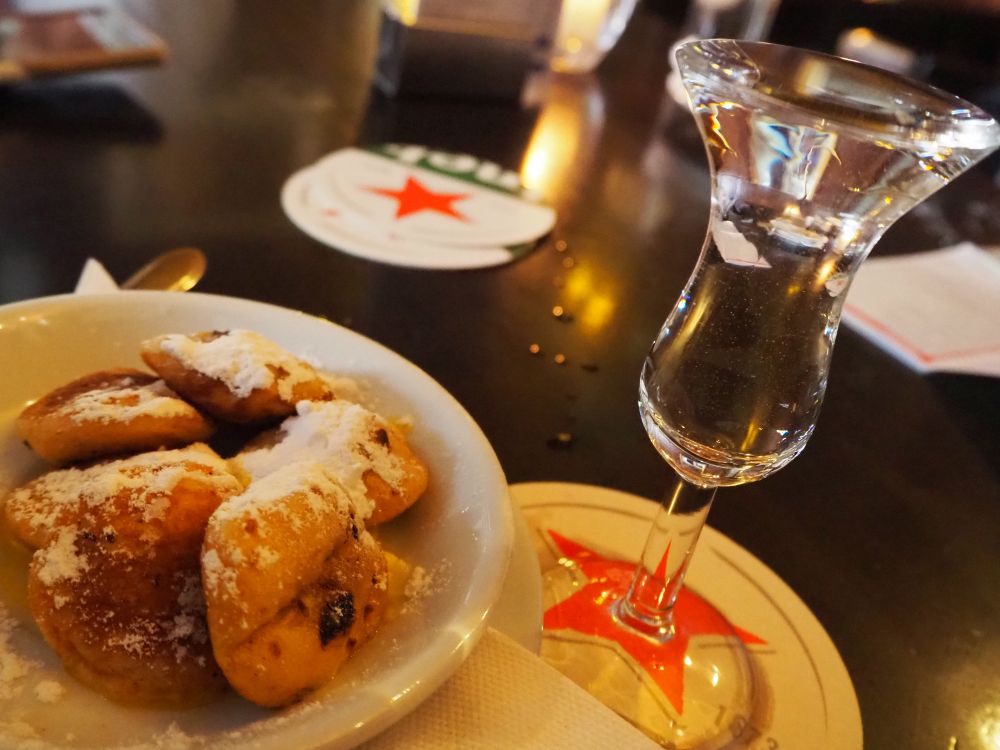
More than just a Jordaan food tour
Kenny was filled with knowledge about the Jordaan and Amsterdam as a whole. He pointed out details like how warehouses were used and how small stones in the facades of some of the houses identified the profession of the people living there. He mixed history with comments about Jordaan life today.
He also told some great stories. For example, he introduced us to eel-pulling, a popular competition in the 19th century in the Jordaan. A live eel would be strung up on a rope across a canal and people would compete to jump up and grab the eel from the rope as they passed underneath in a boat. (Who thinks of these things?)
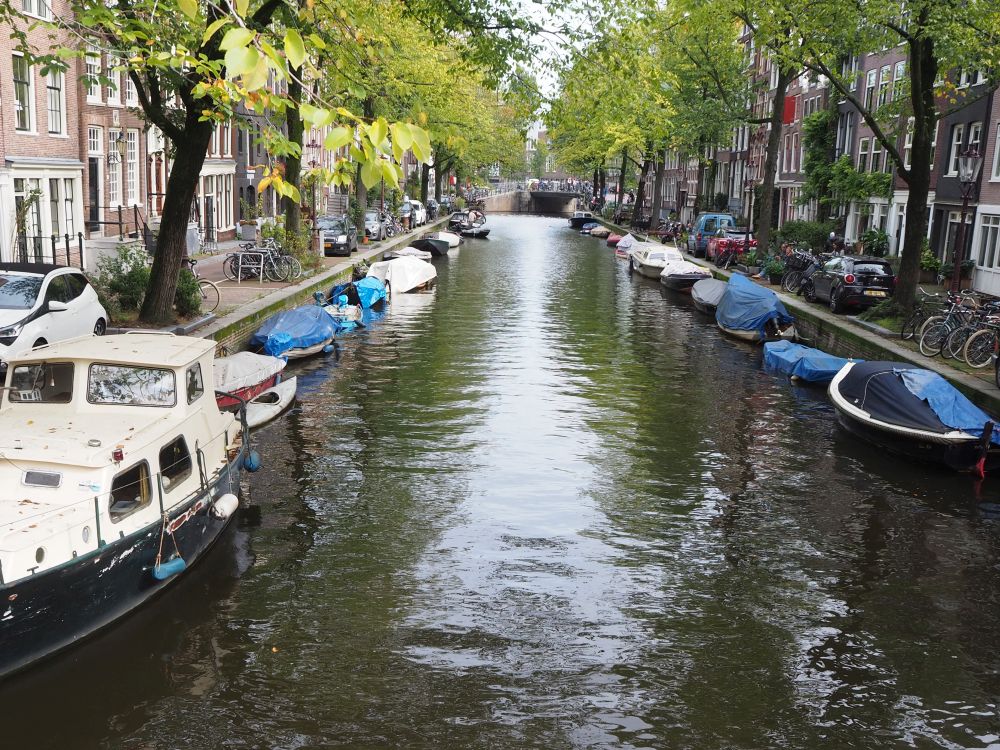
The eel story gets even stranger, though. Eel-pulling became illegal but went on anyway. In 1886 the police came to break up an eel-pulling contest, but the people of the Jordaan resisted, throwing cobblestones at the police. It turned into a riot. The army arrived to reinforce the police and opened fire on the rioters. Twenty-six were killed and many more wounded.
You might also enjoy these other articles about food tours:

My review of the Jordaan food tour
For the rest of the participants on the tour, I think, the Jordaan food tour was a learning experience in terms of the food. The Netherlands isn’t known for food, except maybe cheese, yet we tasted a lot of different items that were all delicious. A country’s culture and history are expressed in its food, and the Netherlands is no exception.
Unlike the others in the group, I had tried all of these foods before. Nevertheless, I learned about their origins and got, over the course of about three hours, twelve different tastes that made up a meal. I enjoyed hearing about the food, the businesses we stopped at and their history, as well as the history of Amsterdam in general and the Jordaan in particular.

It was also a treat to get away from the crowds. Amsterdam suffers from over-tourism and the sheer number of tourists can make moving down a street a difficult endeavor. In the Jordaan, there’s a section that is popular for tourism and has the hip shops and reeking coffee shops I mentioned earlier. The rest of the Jordaan is just a place where people live and work. It’s no longer the humble working-class neighborhood it was, but still holds great charm.
Who would like the Jordaan food tour?
Serious foodies would like this tour, as would anyone who just enjoys food, like me. Holland is not a place people generally visit for the food, yet it has specialties that are delicious and unique. This tour is a good way to get an overview. At the same time, it allows a peek into a special section of the city with its own bohemian atmosphere.

To book the Jordaan food tour that I took, click here.
About Eating Europe
Eating Europe offers food tours in 15 different European cities: Athens, Berlin, Rome, Florence, Amsterdam, London, Prague, Paris, Lisbon, Porto, Naples, Palermo, Venice, Milan, and Strasbourg. I presume it’ll gradually add more. I can’t vouch for any of these from first-hand experience, but if they’re anything like the one I took, they’re worth doing.
In Amsterdam, Eating Europe has three tours: a general one which includes an hour’s boat tour, a tour in an artsy neighborhood called De Pijp with a visit to the Albert Cuyp market, and the Jordaan tour that I took.
If you take one of these, please make sure to come back and add a comment so I can hear how it went!
(Updated August 23, 2024)
My travel recommendations
Planning travel
- Skyscanner is where I always start my flight searches.
- Booking.com is the company I use most for finding accommodations. If you prefer, Expedia offers more or less the same.
- Discover Cars offers an easy way to compare prices from all of the major car-rental companies in one place.
- Use Viator or GetYourGuide to find walking tours, day tours, airport pickups, city cards, tickets and whatever else you need at your destination.
- Bookmundi is great when you’re looking for a longer tour of a few days to a few weeks, private or with a group, pretty much anywhere in the world. Lots of different tour companies list their tours here, so you can comparison shop.
- GetTransfer is the place to book your airport-to-hotel transfers (and vice-versa). It’s so reassuring to have this all set up and paid for ahead of time, rather than having to make decisions after a long, tiring flight!
- Buy a GoCity Pass when you’re planning to do a lot of sightseeing on a city trip. It can save you a lot on admissions to museums and other attractions in big cities like New York and Amsterdam.
- Ferryhopper is a convenient way to book ferries ahead of time. They cover ferry bookings in 33 different countries at last count.
Other travel-related items
- It’s really awkward to have to rely on WIFI when you travel overseas. I’ve tried several e-sim cards, and GigSky’s e-sim was the one that was easiest to activate and use. You buy it through their app and activate it when you need it. Use the code RACHEL10 to get a 10% discount!
- Another option I just recently tried for the first time is a portable wifi modem by WifiCandy. It supports up to 8 devices and you just carry it along in your pocket or bag! If you’re traveling with a family or group, it might end up cheaper to use than an e-sim. Use the code RACHELSRUMINATIONS for a 10% discount.
- I’m a fan of SCOTTeVEST’s jackets and vests because when I wear one, I don’t have to carry a handbag. I feel like all my stuff is safer when I travel because it’s in inside pockets close to my body.
- I use ExpressVPN on my phone and laptop when I travel. It keeps me safe from hackers when I use public or hotel wifi.


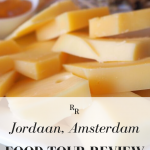

I’ve been to Amsterdam so many times but have never done a food tour. I must do that on my next visit. And those brown cafes, how have I never been to one. (I usually go with Californian friends who only want to do “coffee shops. ” )
There are brown cafes in every city and town. And there are “coffee shops” in every city and town! Make sure you know the difference, though that’s not hard, given the smell! Why would your Californian friends even be interested anymore, now that pot is legal in California?